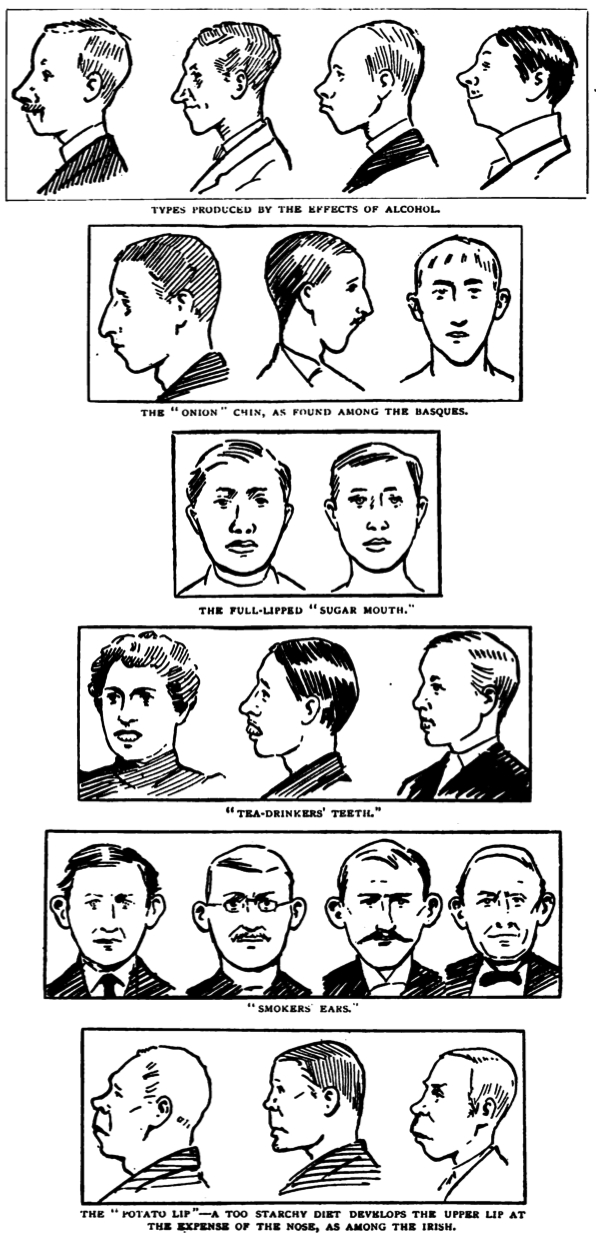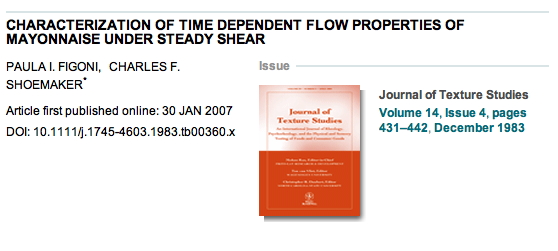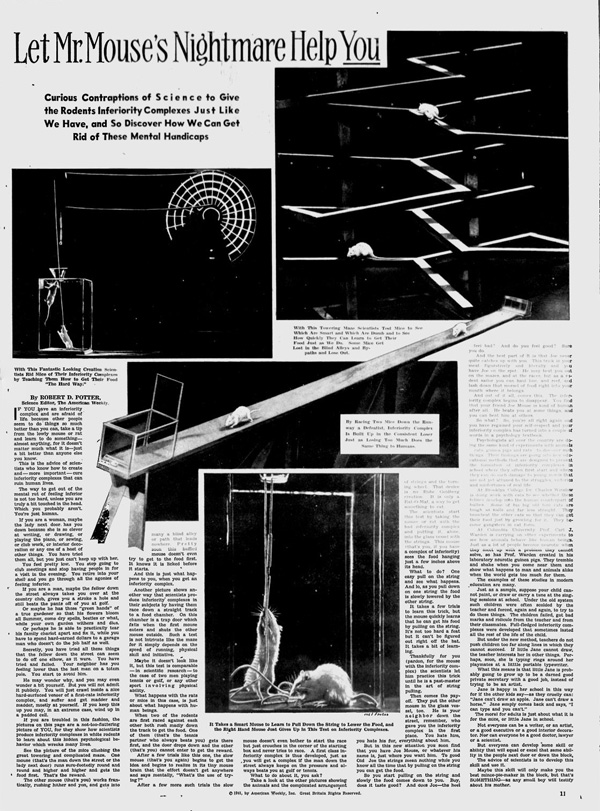Science
The effect of diet on the face
It has been shown, and seemingly conclusively, that a flesh or greatly mixed diet promotes angularity in the face generally, while the nourishment obtained from a single article, commonly of a starchy nature, coarsens the features. Thus we have the potato lip, the oatmeal lip, the maize lip."

From Fauconberg, W. (1905). "The effect of diet and climate on the face." The Strand Magazine: 418-423.
Posted By: Alex - Mon Jul 29, 2013 -
Comments (4)
Category: Body, Food, Science, 1900s
NeverWet Demonstrations
This is not really a commercial for this new Rust-O-Leum product called "NeverWet", but a really cool demonstration of the many uses by some of the research scientists.My favorites are the cardboard box beer cooler and the chocolate and mustard sliding off the white shoes; although there are also demonstrations using cell phones and toilet brushes.
It makes me wonder if you could even wash a treated shirt -- or if it would need it. Could you get it dirty or smelly?
What would you make permanently waterproof?
Posted By: gdanea - Fri Jul 26, 2013 -
Comments (8)
Category: Science
Mayonnaise Flow Rate
As you eat your sandwich, you probably never realized all the science that went into it. Because, of course, some researcher had to study exactly how the mayonnaise flows off your knife onto the bread. [wiley.com]
Posted By: Alex - Sun Jun 30, 2013 -
Comments (2)
Category: Food, Mayonnaise, Science
White Blood Cells in the Sky
NOTE: some enthusiastic swears.
Posted By: Paul - Wed Jun 12, 2013 -
Comments (5)
Category: Annoying Things, Confusion, Misunderstanding, and Incomprehension, Science, Conspiracy Theories and Theorists, Air Travel and Airlines, Nausea, Revulsion and Disgust
Burpless Cows

This is desirable — so much so that the EU is willing to put up €7.7 million in funding for the research — because it's the cow's belches that contain the atmosphere-warming methane. So the plan is that burpless cows will help save us from the spectre of global warming.
Posted By: Alex - Fri Jun 07, 2013 -
Comments (5)
Category: Science, Cows
Eating Wood—the latest advance
I've posted before about the centuries-old scientific dream of using sawdust to feed the world. So the latest effort in this vein caught my eye. A Virginia Tech researcher has figured out a way to enzymatically transform indigestible cellulose into edible starch. The science seems sound. The only problem is that the process is too expensive for commercial production. But it's a start!The article points out that most of us are eating wood (or cellulose) already. It's a common additive in the fast-food industry. But it's indigestible, so people couldn't survive on it. Its purpose is to add texture, or "mouth feel."
opb.org
In a study published this spring with colleagues in the Proceedings of the National Academy of Sciences, Zhang explains a process he developed to transform solid cellulose — which could come from wood, grass or crop residue (like corn husks) — into a carbohydrate called amylose. The process is a form of synthetic biology and relies on enzymes to break down the cellulose into smaller units and then restitch the molecules into starch. That means the final, edible food product — a powder that Zhang says tastes sweet — is completely synthetic but resembles other complex carbohydrates like corn starch.
Posted By: Alex - Thu Jun 06, 2013 -
Comments (6)
Category: Food, Science
Let Mr. Mouse’s Nightmare Help You!
Psychotherapy via mouse torture. Milwaukee Sentinel - Nov 16, 1941.
Posted By: Alex - Wed May 29, 2013 -
Comments (7)
Category: Science, Psychology, 1940s
Earthquake-Predicting Dogs
Over in China, researchers decided to test the theory that dogs can predict earthquakes. So they housed four dogs at the Nanchang quake center and waited for them to show signs of "abnormal" activity, such as barking a lot.They soon discovered that dogs (and apparently these dogs in particular) often bark a lot. According to local residents "every night at 11pm they start barking over and over." After fielding multiple complaints from angry neighbors, the researchers "offered to muzzle the dogs, but accepted later that this might impede their skills as quake-prognosticators." Finally, the experiment was shut down.
So maybe dogs can predict earthquakes, or maybe they can't. But until we learn to speak dog language better, it doesn't look like our canine friends will be much use to us as official quake predictors. [London Times]
Posted By: Alex - Fri May 10, 2013 -
Comments (4)
Category: Science, Experiments, Dogs
The Experimenting Preacher

Back in 1959, Rev. David Allcorn mixed science and religion by conducting chemical experiments while at his pulpit in order to "enliven his sermons." He worked as a chemist at the National Biscuit Co. before becoming pastor of the Immanuel Evangelical United Brethren Church in Pittsburgh, PA.
Posted By: Alex - Thu Apr 18, 2013 -
Comments (6)
Category: Religion, Science, 1950s
Quantum Daughter
Posted By: Paul - Wed Mar 20, 2013 -
Comments (0)
Category: Science, Surrealism, Stop-motion Animation

| Who We Are |
|---|
| Alex Boese Alex is the creator and curator of the Museum of Hoaxes. He's also the author of various weird, non-fiction, science-themed books such as Elephants on Acid and Psychedelic Apes. Paul Di Filippo Paul has been paid to put weird ideas into fictional form for over thirty years, in his career as a noted science fiction writer. He has recently begun blogging on many curious topics with three fellow writers at The Inferior 4+1. Contact Us |




